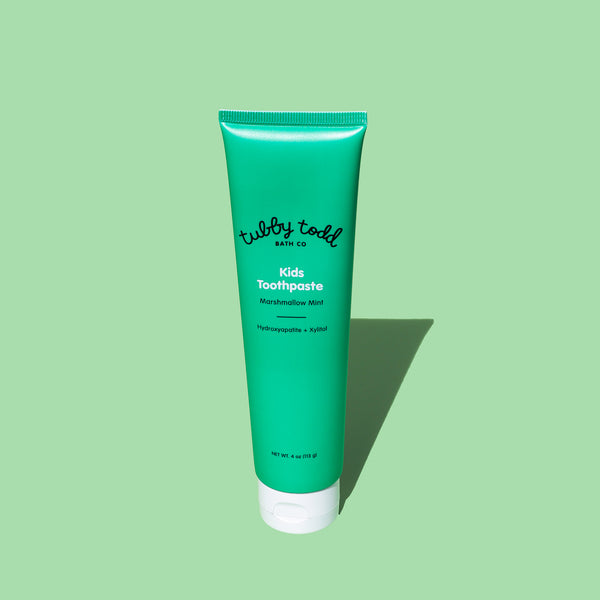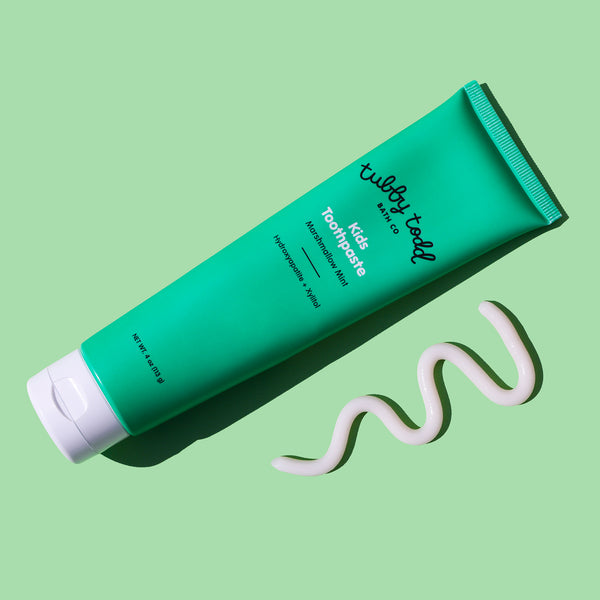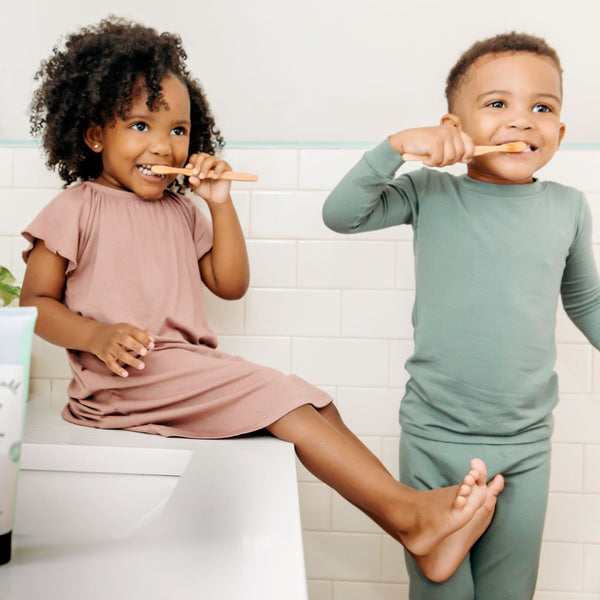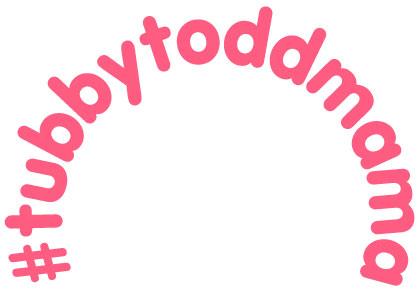
When that first tiny tooth pokes through, it’s more than just a milestone, it’s the start of a brand new chapter in your little one’s care routine. And while it may feel early to start thinking about brushing, establishing healthy oral hygiene from the beginning is one of the best habits you can build for your baby (and your sanity down the road).
So let’s talk about it, mama. We’re breaking down how to brush baby teeth, how often to do it, what tools to use, and why it matters—plus a few tricks to make it easy and even fun.
When should you start brushing baby teeth?
Short answer? As soon as that first tooth appears!
Most babies get their first tooth around 6 months (though anywhere between 4–12 months is totally normal). And once that little pearly white shows up, it’s time to start a gentle brushing routine.
But even before teeth arrive, it’s a good idea to start gently wiping your baby’s gums once a day with a soft, damp cloth or silicone finger brush. This keeps their mouth clean, gets them used to the routine, and builds trust around oral care. So by the time you introduce a toothbrush, it feels familiar, not scary (for them, it’s ok if it’s scary for you).
How to brush baby teeth (step-by-step)
Brushing baby teeth doesn’t need to be complicated, but it does require a little intention, and a whole lot of gentleness. At this stage, you’re not just cleaning teeth. You’re introducing your little one to a new daily ritual, one that helps them feel safe, loved, and cared for. It’s less about perfection, and more about creating consistency and trust.
Here’s a simple, stress-free routine to follow:
Step 1: Choose the right toothbrush
Use a soft-bristled baby toothbrush with a small head that fits comfortably in their mouth. For early teethers, a silicone brush or finger brush is a great transition tool.
Step 2: Use the right toothpaste for babies
Use a smear (think rice grain-sized) of a gentle, fluoride-free toothpaste designed for infants. Our Tubby Todd Training Toothpaste is free of harsh ingredients and tastes like mild, yummy watermelon—perfect for first-timers still learning to spit.
Step 3: Brush gently
Cradle your baby in your lap (or whatever position they’re the most comfortable in), gently tilt their head back, and softly brush each tooth and along the gumline. Use small circular motions and speak to them gently while brushing. The goal is to create a calm, positive experience, not a power struggle.
Step 4: No rinsing necessary
Since you’re using toothpaste for babies, there's no need to rinse. Just wipe any extra toothpaste from their lips or chin if needed.
Step 5: Celebrate and repeat
Give a little praise or sing a brushing song. Making it playful now can help build cooperation later.
How often to brush baby teeth
It’s best to brush baby teeth twice a day, once in the morning after their first feed and again before bed. It can feel a lot, but you can do it! The key is staying consistent and building a habitual routine.
We get it though, life with a baby is unpredictable. If you’re in survival mode some days, focus on the bedtime brush to clear away milk residue and bacteria before the overnight stretch. That’s when saliva production drops and cavities are more likely to form.
Eventually, twice a day will become part of your daily rhythm. Starting early builds that foundation.

Why brushing baby teeth matters (even before they eat solid food)
You might be wondering why it’s so important to brush teeth that haven’t even seen a bite of real food yet. Great question.
Even breastmilk and formula contain sugars that can settle on the teeth and gums. Add to that the fact that baby teeth are thinner and more porous than adult teeth, and therefore more vulnerable to decay—you can see why oral care is more than just cosmetic.*
Getting into the habit of brushing helps:
-
Prevent tooth decay and baby cavities (yes, they’re real!)
-
Build trust and routine for toddler tooth care later
-
Support speech development and overall oral health
-
Keep their mouth clean and comfortable during teething
Let’s be honest, those tiny teeth are just too cute not to care for properly.
Tips to Make Brushing Baby Teeth Easier
Some babies are chill about brushing. Others? Not so much. If your little one clams up, cries, clenches their mouth shut, or turns their head every time you reach for the toothbrush, you’re not alone, and you’re not doing anything wrong.
At this stage, brushing isn’t just a new sensation. It’s also a new boundary. Your baby may not love the idea of someone poking around in their mouth (fair!), especially when they’re teething, tired, or just not in the mood.
But don’t worry, mama. With a little patience and a few gentle tricks, it gets easier:
-
Make it playful: Use a silly voice, give them a big smile, make up a brushing song, or turn brushing into a game (“Let’s find that sneaky tooth!”). If your baby senses that brushing time is fun, not stressful, they’re more likely to cooperate.
-
Let them explore the brush: Give them their own toothbrush to hold and chew while you guide another one. Babies love feeling in control, and this also helps normalize the sensation of brushing.
-
Brush together: Babies love copying what you do. Let them watch you brush your own teeth—even exaggerate your movements and smile a lot. Modeling helps them feel like brushing is something everyone does.
-
Try brushing in front of a mirror: Seeing both of you in the mirror can make the experience feel like a shared moment. Plus, babies love watching their own reflection.
-
Use a silicone brush on teething days: It can double as a gum massager and help them associate brushing with soothing relief.
And remember: it’s okay if it doesn’t go perfectly every time. Keep your tone calm, your expectations flexible, and your approach consistent. The goal is to build a positive association with brushing, not force perfection.
Even a few seconds of gentle brushing is a step in the right direction. Over time, your little one will get used to the routine, and maybe even look forward to it.

What to Look for in a Baby Toothpaste
Not all baby toothpastes are created equal. When choosing one, look for a formula that’s:
-
Fluoride-free for early brushers (before they learn to spit)
-
Free of artificial dyes and flavors
-
Gentle enough for tiny teeth and gums
-
Lightly flavored to make the experience more pleasant (but not overwhelming)
Our Tubby Todd Toothpaste checks all the boxes. It's clean, effective, and developed for tiny mouths that deserve the best start.
Bonus Step: Caring for Baby Gums and Tongue
Even before your baby’s first tooth shows up, it’s a good idea to gently wipe their gums and tongue after feedings. This removes milk residue and introduces the idea that oral care is just part of the daily routine.
To do this use:
-
A damp, soft washcloth
-
A silicone finger brush
-
Or a soft baby oral wipe
This simple step can also help reduce bad breath and keep their gums healthy for the teeth to come.

The Takeaway
Brushing baby teeth doesn’t have to feel overwhelming. With the right tools, a gentle touch, and a little consistency, you can help your baby build healthy habits that last a lifetime.
Start slow, stay calm, and focus on connection. This isn’t just about teeth, it’s about care, comfort, and confidence. And you’ve got this, mama.
Shop Tubby Todd Oral Care for gentle toothpaste and brushing essentials that make baby’s first brushings feel safe, simple, and even sweet.






